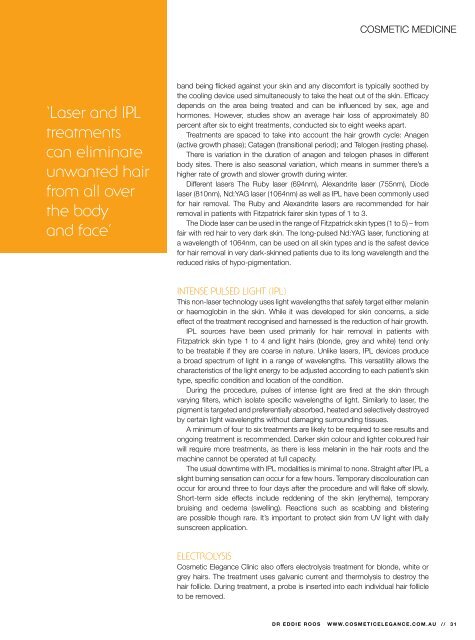You also want an ePaper? Increase the reach of your titles
YUMPU automatically turns print PDFs into web optimized ePapers that Google loves.
COSMETIC MEDICINE<br />
‘Laser and IPL<br />
treatments<br />
can eliminate<br />
unwanted hair<br />
from all over<br />
the body<br />
and face’<br />
band being flicked against your skin and any discomfort is typically soothed <strong>by</strong><br />
the cooling device used simultaneously to take the heat out of the skin. Efficacy<br />
depends on the area being treated and can be influenced <strong>by</strong> sex, age and<br />
hormones. However, studies show an average hair loss of approximately 80<br />
percent after six to eight treatments, conducted six to eight weeks apart.<br />
Treatments are spaced to take into account the hair growth cycle: Anagen<br />
(active growth phase); Catagen (transitional period); and Telogen (resting phase).<br />
There is variation in the duration of anagen and telogen phases in different<br />
body sites. There is also seasonal variation, which means in summer there’s a<br />
higher rate of growth and slower growth during winter.<br />
Different lasers The Ru<strong>by</strong> laser (694nm), Alexandrite laser (755nm), Diode<br />
laser (810nm), Nd:YAG laser (1064nm) as well as IPL have been commonly used<br />
for hair removal. The Ru<strong>by</strong> and Alexandrite lasers are recommended for hair<br />
removal in patients with Fitzpatrick fairer skin types of 1 to 3.<br />
The Diode laser can be used in the range of Fitzpatrick skin types (1 to 5) – from<br />
fair with red hair to very dark skin. The long-pulsed Nd:YAG laser, functioning at<br />
a wavelength of 1064nm, can be used on all skin types and is the safest device<br />
for hair removal in very dark-skinned patients due to its long wavelength and the<br />
reduced risks of hypo-pigmentation.<br />
INTENSE PULSED LIGHT (IPL)<br />
This non-laser technology uses light wavelengths that safely target either melanin<br />
or haemoglobin in the skin. While it was developed for skin concerns, a side<br />
effect of the treatment recognised and harnessed is the reduction of hair growth.<br />
IPL sources have been used primarily for hair removal in patients with<br />
Fitzpatrick skin type 1 to 4 and light hairs (blonde, grey and white) tend only<br />
to be treatable if they are coarse in nature. Unlike lasers, IPL devices produce<br />
a broad spectrum of light in a range of wavelengths. This versatility allows the<br />
characteristics of the light energy to be adjusted according to each patient’s skin<br />
type, specific condition and location of the condition.<br />
During the procedure, pulses of intense light are fired at the skin through<br />
varying filters, which isolate specific wavelengths of light. Similarly to laser, the<br />
pigment is targeted and preferentially absorbed, heated and selectively destroyed<br />
<strong>by</strong> certain light wavelengths without damaging surrounding tissues.<br />
A minimum of four to six treatments are likely to be required to see results and<br />
ongoing treatment is recommended. Darker skin colour and lighter coloured hair<br />
will require more treatments, as there is less melanin in the hair roots and the<br />
machine cannot be operated at full capacity.<br />
The usual downtime with IPL modalities is minimal to none. Straight after IPL a<br />
slight burning sensation can occur for a few hours. Temporary discolouration can<br />
occur for around three to four days after the procedure and will flake off slowly.<br />
Short-term side effects include reddening of the skin (erythema), temporary<br />
bruising and oedema (swelling). Reactions such as scabbing and blistering<br />
are possible though rare. It’s important to protect skin from UV light with daily<br />
sunscreen application.<br />
ELECTROLYSIS<br />
<strong>Cosmetic</strong> Elegance Clinic also offers electrolysis treatment for blonde, white or<br />
grey hairs. The treatment uses galvanic current and thermolysis to destroy the<br />
hair follicle. During treatment, a probe is inserted into each individual hair follicle<br />
to be removed.<br />
DR EDDIE ROOS WWW.COSMETICELEGANCE.COM.AU // 31


















